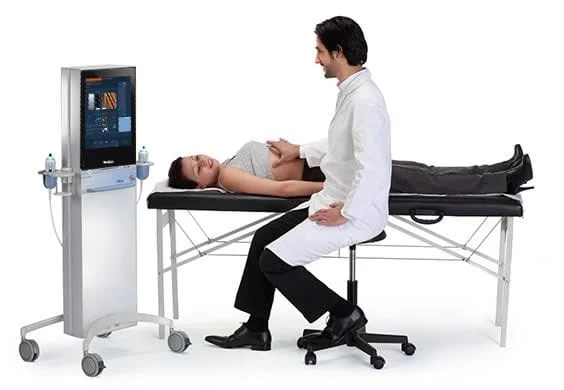Gastroenterology Practice Associates now offers FibroScan®, a non-invasive, lower cost, no-risk way that allows our physicians to diagnose and monitor disease evolution in conjunction with treatment. The exam results help to anticipate various complications, as well as to monitor and assess the damage caused by conditions such as cirrhosis.
Video for patients on the FibroScan examination experience
Liver Overview
The liver is the largest solid organ in the human body. It receives about 1.5 liters of blood per minute, and is involved in three major vital functions that are essential to our body: cleansing, synthesis, and storage.
The cleansing function: The liver collects toxins from your body, alters them to make them harmless, and then eliminates them. It destroys old red and white blood cells, as well as certain bacteria present in the blood. It destroys the toxins that come naturally from the waste products produced by our body, such as ammonia, as well as toxins that we ingest, such as alcohol. It neutralizes the drugs we absorb after they have taken effect, and thus prevents any dangerous accumulation.
The synthesis function: The liver is involved in metabolizing carbohydrates, lipids (cholesterol, triglycerides), and proteins (albumen). It has an essential role in the production of coagulation factors, to prevent hemorrhaging. It is involved in the production and secretion of bile (600 to 1200 ml per day), which is stored and concentrated in the gall bladder.
The storage function: The liver stores the fat-soluble vitamins (A, D, K, and E) and glycogen. It thus stores energy in the form of sugar and makes it available to the body in case of need.
What are the main fibrogenic pathologies of the liver?
About 10% of the US population has some form of liver disease. There are many diseases that can cause the gradual development liver fibrosis, that in turn, may develop into cirrhosis. The most common cause of cirrhosis in in the United States is Non-Alcoholic Liver Disease (NASH). Alcoholic liver disease is the second most common cause at 36%, followed by Chronic viral hepatitis (B and C) combined causes 15% of liver disease, and other diseases including auto-immune diseases (primary biliary cirrhosis and auto-immune hepatitis), accounting for only 3% of liver disease.
Other Causes of Chronic Liver Disease
Primary biliary cirrhosis (PBC): This is an inflammatory disease of the small intrahepatic bile ducts. It is most often found in women over 40, and its cause is unknown. The term 'cirrhosis' is inappropriate, because cirrhosis is present only in the advanced forms. The presence of anti-mitochondrial antibodies is observed in most patients.
Auto-immune hepatitis: This is an inflammatory disease of the small intrahepatic bile ducts. It is most often found in women over 40, and its cause is unknown. The term 'cirrhosis' is inappropriate, because cirrhosis is present only in the advanced forms. The presence of anti-mitochondrial antibodies is observed in most patients. Auto-immune hepatitis: This is an inflammatory disease of the liver, which can occur at any age, characterized by elevated liver enzymes and gammaglobulin levels (immunoglobulin G) as well as the presence of autoantibodies (antinuclear antibodies, anti-smooth muscle antibodies, anti-LKM antibodies). It more often affects women.
Genetic haemochromatosis: This is a genetic condition caused by deficient regulation of the intestinal absorption of iron. Iron accumulates in the tissues, and particularly in the liver, causing fibrosis and then cirrhosis. This disease is ten times more common in men than women (because of the loss of iron during menstruation), and is recognized in the 40-60 age range. The treatment for haemochromatosis involves performing repeated bleeding to reduce the iron deposits in tissues.
Wilson's disease: This is a genetic disease caused by the accumulation of copper in the liver. The cornea and the central nervous system can also be affected. This is unusual.
What is FibroScan®?
Examination with FibroScan®, also called transient elastography, is a technique used to assess liver stiffness (measured in kPa correlated to fibrosis) without invasive investigation. The result is immediate, it shows the condition of the liver and allows physicians to diagnose and monitor disease evolution in conjunction with treatment and collateral factors. Exam results help to anticipate various complications, as well as to monitor and assess the damage caused by conditions such as cirrhosis. The FibroScan® examination is painless, quick and easy. During measurement, you feel a slight vibration on the skin at the tip of the probe.

What does the FibroScan® examination consist of?
- You lie on your back, with your right arm raised behind your head. Physician applies a water-based gel to the skin and places the probe with a slight pressure
- The examination includes 10 consecutive measurements made at the same location
- The result is delivered at the end of the examination, it's a number which can vary from 1.5 to 75 kPa. Your doctor will interpret the result
What does the result mean?
Your physician interprets the result according to your history and underlying disease.
Who can prescribe the FibroScan® examination?
Your physician will indicate the most appropriate time for you to have the examination.
What difference does FibroScan® make to me?
- Fibroscan® provides immediate results, it's easy and fast (5-10 minutes)
- The exam is painless and non-invasive
- In case of close follow-up, the examination can be safely repeated

